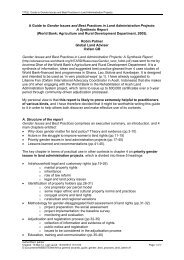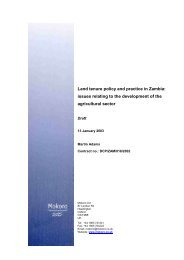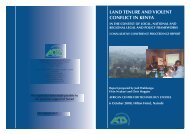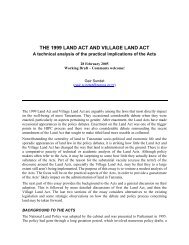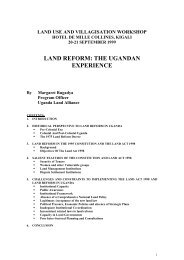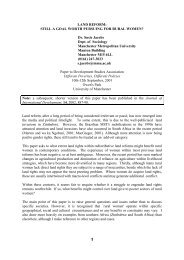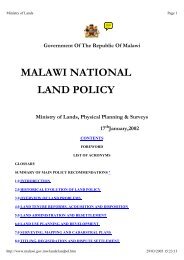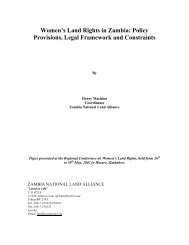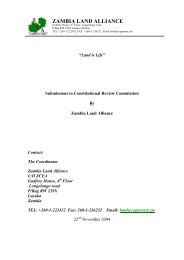Download - Mokoro
Download - Mokoro
Download - Mokoro
- No tags were found...
Create successful ePaper yourself
Turn your PDF publications into a flip-book with our unique Google optimized e-Paper software.
6production involve a great variation of sizes of groups, ranging from a few families tolarge projects involving hundreds or even thousands of households. The largest projectsare within community restitution claims, with some projects involving as many as 1,000households or 6,000 beneficiaries (CRLR 2004).Large groups of poor people attempting group production, with minimal external supportand limited capital beyond the balance of land acquisition grants, were widely blamed forthe problems encountered in Settlement / Land Acquisition Grant (SLAG) projects(MALA 2000). To accumulate sufficient grant finance to purchase whole farms,applicants galvanized large groups – some of whom may have had little intention to liveon or use the land but remained often passive members of communal propertyassociations (CPAs) or other legal entities. This “rent-a-crowd” syndrome as it becameknown was considered a key failing of the first phase of land reform, though arguablyunder-utilisation of land and limited livelihood benefits did not only emanate from groupdynamics (Hall and Williams 2003, MALA 2000). Despite the redesign of the grantformula through the Land Redistribution for Agricultural Development (LRAD)programme, provision of grants on an individual rather than household basis, and thepossibility of leveraging higher grants with own contributions and loans, group-basedprojects – sometimes with smaller membership than before – have continued to be thedominant model under LRAD since its inception in 2001 (Jacobs et al 2003, MALA2003). The availability of grants on an individual basis has limited the need for pooling ofgrants, and thus enabled smaller project sizes, though this has been offset by the failureto index the grant to an inflationary index; while land prices have risen, the level ofgrants has remained the same (and thus, in real terms, has declined over time) (MALA2003:20-21).Group projects, then, remain typical within the LRAD programme, despite attempts tolimit the group size (Jacobs et al 2003). Group-based projects frequently involve not onlyjoint ownership of the land but also the pooling of assets and labour, and even extend toherds of cattle belonging to the CPA, often alongside cattle owned by individualmembers. For instance, at Dikgolo and Monyamane projects in Limpopo, no provisionwas made for the livestock already belonging to project members. Instead, thecommercial land use plan required that beneficiaries use their grant funding to build upcommercial beef herds (PLAAS 2007).Group-based land reform has been characterised by its critics as the “extension of thebantustans”. However, land reform projects where land is collectively farmed are quitedifferent from the communal areas. Land use in communal areas is communal ratherthan collective, in that while land and other resources may be held in common andmanaged on a group basis, production is typically household-based (Andrew et al 2003,Shackleton et al 2002). The household is usually the unit of production, rather than “thecommunity” (Andrew et al 2003). This must be contrasted with communal propertyassociations (CPAs) and other legal entities established through land reform, where notonly administration and management of land, but also production, is communalised(CSIR 2005). Many, and almost certainly the majority, of land reform projects aretherefore envisaged as production collectives (Lahiff 2007). A review of LRAD in 2003proposed instead a variety of “production models” and argued that attempts to create“instant successful replicas of white commercial farmers” had been the cause ofdisappointing outcomes of land reform (MALA 2003:16).Policy Options for Land and Agrarian ReformProgramme for Land and Agrarian Studies, University of the Western Cape




